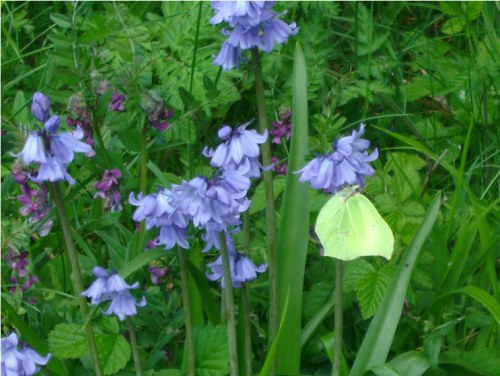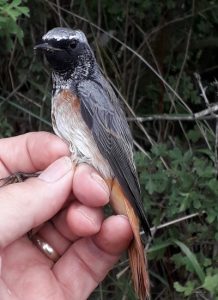Most people will think of Upham Meadow at Twyning as a Lammas Meadow, one of the traditional Severn and Avon Vale riverside meadows, which floods in winter and produces a hay crop in summer. It is a Site of Special Scientific Interest because of its nesting hay meadow birds – in particular Curlews, Redshanks, until recently Corn Buntings, with Reed and Sedge Warblers round the edges, and many pairs of Reed Buntings. It’s also well known for its hay meadow botany, and is particularly rich in species like Meadowsweet and Great Burnet, as well as two species of Water Dropwort, the Narrow-leaved and the Tubular. This natural diversity is maintained by traditional farming practices: no fertiliser (the river floods bring enough of that); no spraying (which means that Ragwort is a problem); hay cutting beginning on 15 June and proceeding strip by strip until Lammas Day in early August; prohibited access in the summer months; then aftermath grazing by commoners who have grazing rights. The whole system is overseen by the Haywarden, one of the owners of the strips of land. This system is supported by current agri-environmental schemes, managed by Natural England.

In autumn and winter, before the floods rise, the site is grazed by sheep and cattle. Among the species present are large numbers of Canada Geese, and in recent winters some of these birds have proved to be carrying engraved colour rings, which were put on in midsummer, of all places at Windermere. The birds go there during the moult period, when they are flightless, and need to keep well out of the way of marauders. Having renewed their flight feathers, they make for the Severn and Avon Vales to winter. One of these Canada Geese was marked at Bowness in Windermere in July 2013, with a red ring bearing the inscription AASK in white letters. I have since seen this same bird with the same ring, at Upham Meadow in November and December 2014, February, October and December 2015 and in November 2016; I didn’t manage to find it in winter 2017/18, so was pleased to observe it again on 17 November 2018, back in familiar surroundings. It is clearly very faithful to this site.

While I was pleased to see Canada AASK again, a much more surprising find was a Greenland White-fronted Goose Anser albifrons flavirostris, among a flock of just over a hundred Canada Geese. The Greenland Whitefront is the subspecies of Whitefront that nests in Greenland, and passes through Iceland to winter in Ireland and western Scotland; it was first named by Sir Peter Scott who named it for its yellow bill (‘flavirostiris’), yellow legs and heavier barring on the belly. It is fairly unusual in Gloucestershire – The “Birds of Gloucestershire” indicates that it has occurred, mainly at Slimbridge, in about 20 winters since 1945, generally birds which overshot Ireland on their way southeast. This subspecies is relatively easy to distinguish from the European Whitefront Anser albifrons albifrons which breeds in Russia and migrates through western Europe, reaching Slimbridge as its most westerly wintering site.
When I looked more closely at the bird – even more exciting – I found it had a satellite transmitter round its neck, so (if the transmitter was working) there was a chance of finding out more about the route it had taken to reach Twyning. The bird was seen a bit later on the Worcestershire bank near Fleet Lane by Andy Warr who took the attached pictures, which clearly show the transmitter, and the yellow bill. It has been seen since then in several sites on the Worcestershire border, at least until 20 November.
I sent this information to goose expert Dr Tony Fox, once of Slimbridge, now working in Denmark as a key figure in international goose studies, and for many years a specialist in Greenland Whitefront. His response was as follows:
“This bird was indeed an adult female Greenland White-fronted Goose caught in Hvanneyri, West Iceland, on 23 September 2017; after several days at Hvanneyri, she shifted westwards within Iceland to spend the remaining time staging in Myrar. That autumn she overshot Wexford (literally overflying County Waterford), hit the Brittany coast and looped round back over Cornwall to arrive finally at Wexford, where she wintered.
“In autumn of 2018, she left Iceland on 24 October sometime after 14:37 UTC and was mid-way across the sea at 02:00 on 25 October, but was clearly drifting very far east, ending up in mid North Sea, arriving off Texel at 17:00. She clipped Goeree, south of Rotterdam, at 20:00, and a little later left the Belgian coast off Zeebrugge, reaching the English coast at 00:30 on 26 October at the mouth of the Deben Estuary. She looped southwest and departed the southern English coast between Newhaven and Seaford, heading for the French coast, which she reached at about 07:00 same day, just north of Le Havre. Clearly not satisfied with her landfall, she headed NE and just inland of Calais and at around 12:00 swung NW and crossed the Channel again, coming into NE Kent in mid-afternoon on 26 October. She headed for the north coast and seemed to rest on the sea (the first time she seems to have rested since leaving Iceland) between 19:00-21:00 between Birchington-on-Sea and Herne Bay. She seemed to land in a field just inland from there, but at midnight set off west, following the north coast of Kent, continuing over south London (just south of Heathrow at 15:00 on 27 October). She stopped briefly for a few hours from 19:00-21:00 in fields near Aynho, at the southern end of Northamptonshire before heading on, and probably roosted in north Gloucestershire before heading onwards. By 17:50 on 28 October she reached gravel pits at Great Comberton and has been on the Gloucestershire/Worcestershire border ever since.
The map below shows her itinerary, as revealed by the satellite. This all shows that Upham Meadow is interesting not just for Curlews and Water-Dropwort!

STOP PRESS: Latest news of the Greenland Whitefront: the transmitter suddenly stopped working overnight on 20 November, when the bird was known to be roosting at Kemerton Lake in south Worcestershire. It was feared that the bird had been predated, perhaps by a fox? Careful searches of the site revealed no corpse and no transmitter, and searches for the bird among flocks of Canada Geese were also unsuccessful. Fortunately, however, it turned out that the fears were groundless: the transmitter started working again (sending a signal every 15 minutes), and in the last few days of November, she has visited Ripple Lake and Longdon Marsh in Worcestershire, and Tirley and Coombe Hill in Gloucestershire. Incidentally, while the neck collars may look ugly and cumbersome, Tiny Fox comments: “We started by using backpacks back in the 1990s, but had huge problems with geese ripping out the antennae and chewing through harnesses. There have been some published analyses of using different types of attachment on geese, and the prevailing wisdom is that collar mounted devices are by far the best for the survival and fitness of the birds.”
Mike Smart























